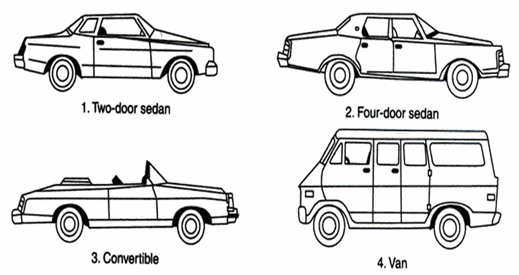Introduction to Automobile Body
Body is nothing but the 'face structure'
of the automobile. Body is only aspect to provide ergonomics feature in any
automobile. Automobile body have front, side and back view for showing its
styles. It consist of doors, windows, side panels, fenders, front & rear
bumpers, grille, pillar etc. A body sometimes referred to as "coachwork".
The body is that part where passengers
have occupies their seats or the luggage and other placed cargo to be carried.
Body is built on the chassis to complete
the vehicle. Chassis & body makes the complete automobile vehicle. For
small & light car, body & chassis are made as a single unit but in
large vehicles both are made as a single unit.
Generally body surface is made from metal
or fibre. The body is usually made from a large number of steel pressings which
are welded together. The body is bolted to the chassis at numerous points. The
rubber or felt-strips being interposed to damp-down (reduce) the vibrations and
noise.
Main purpose of the body is to provide
safety, comfort, protection & pleasant environment for all the passengers
& also the good look.
Most of vehicles Body should fulfil the
following requirements:
The body should be light.
It should have minimum number of
components.
It should provide sufficient space for
passengers and luggage.
It should withstand vibrations while in
motion.
It should offer minimum resistance to air.
It should be cheap and easy in
manufacturing.
It should be attractive in shape and
color.
It should have uniformly distributed load.
It should have long fatigue life.
It should provide good vision and
ventilation.
Classification of Automobile Body:
Automobile bodies are classified on the
basis of namely; according to major groups, chassis design, class of vehicle,
requirement or application based.
The Automobile bodies are divided in two
major groups namely:
Passenger Body
Commercial body.
According to Chassis design the body can
divided into:
Conventional Type
Integral Type
Semi- Integral Type
According to class of vehicle:
Light vehicle Bodies – cars, jeeps
Heavy vehicle Bodies – Busses, Lorries
Medium vehicle Bodies – Vans, Matadors
According to requirement / as per
application of the vehicle:
Car body
Straight truck or Punjab truck body
Truck with half body
Platform type truck body
Tractor body
Tractor with articulated trailer
Tanker body
Bus body or coach work
Dumper truck body
Delivery van body
Station wagon body
Pick up van body
Jeep body
Long wheel base truck body etc.
Transport or commercial vehicle body -
Fleet transport vehicle, Transport vehicle, Ambulances vehicle, Transport of
Army personal, Ammunition, different types of tanker vehicles etc.
If it is a private vehicle, the vehicle is
used for luxury personal travelling, private cargo transport etc., namely car,
Minivan, Omni bus, Matador etc.
If it is commercial vehicle the vehicle is
used for transportation of goods some other vehicles, freezer boxes etc.
If it is tanker, it is used to transport
milk, water, edible oils, petroleum products, gases, acids etc. The tanker
bodies are designed according to the relevant requirement.
 |
| Fig 1.54: Different automobile bodies |
If it is a private vehicle, the vehicle is
used for luxury personal travelling, private cargo transport etc., namely car,
Minivan, Omni bus, Matador etc.
If it is commercial vehicle the vehicle is
used for transportation of goods some other vehicles, freezer boxes etc.
If it is tanker, it is used to transport
milk, water, edible oils, petroleum products, gases, acids etc. The tanker
bodies are designed according to the relevant requirement.
If it is an army vehicles, the vehicle are separately
designed namely Arm truck, heavy long wheel base cargo trucks, long platform
trucks etc. These are exclusively used to carry the army personal, arms and
ammunition's etc.
Some automobiles manufacturing companies are using
long wheel base trucks with closed body structure for transporting of the
vehicle produced in their factories to different market outlets.
The private vehicles used in
different fields namely Buses of different types, Air Conditioned Buses,
Station Wagons etc., Usually Road Transport organization of a state is a fleet
organized jointly by the state Government an exclusive body which is to operate
buses for travelling of passenger to various places within the state as well as
Inter-State travelling also the Road transport corporation organization is
having differently designed buses namely ordinary body buses, Deluxe buses ,
semi luxury buses, Air conditioned buses and also buses with sleeper coach etc.
Types of car body:
(i) Closed cars:
(a)Saloon— has two or four doors, a single compartment with two
rows of seats, one at the front and the other at the rear. There is a separate
luggage space at the rear or at the front.
(b) Hatchback — a saloon with a door at the back is called
hatchback.
(c) Coupe — in this type there is only one row of seats
for two persons.
Only two doors are provided. An ordinary 'saloon' with
roof -line at decreased height is also called coupe sometimes. The term G.T.
(grand touring) added to `coupe' means a car of performance which is better
than the average.
(d) Limousine — driving compartment is separated from the rear
compartment by a sliding glass division.
(ii) Open cars:
(a) Sports – has two doors or less, is provided with a
collapsible hood, a fold -flat windscreen and removable side -screens.
(b) Convertible – the roof in this is of soft
folding type and windows of special wind-up design. With these provisions the
car may be either open or enclosed.
(iii) Special styles:
(a) Estate Car – a saloon car with the passenger roof extended right up to the rear end. Rear door is use for loading with rear seats usually collapsible.
 |
| Fig 1.55: Different Car bodies |




interstate vehicle transport
ReplyDeletecar transport australia
car transport service
best car transport companies
interstate vehicle transport
car transport carriers
interstate vehicle transport
ReplyDeletecar transport australia
car transport service
best car transport companies
interstate vehicle transport
car transport carriers